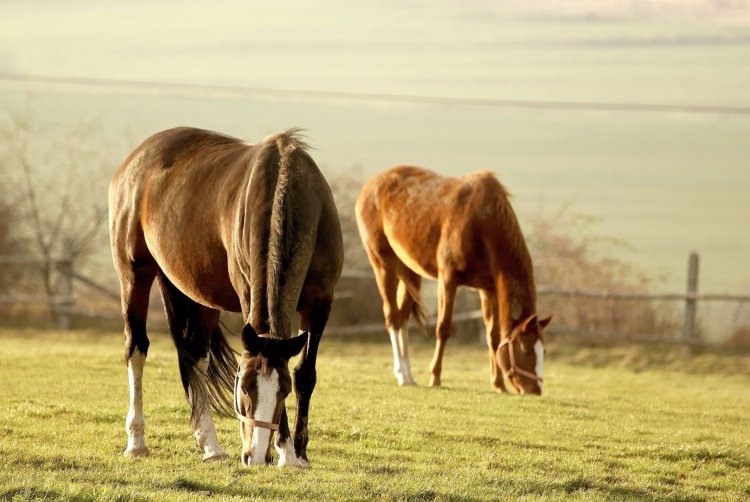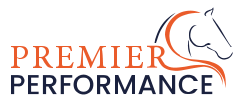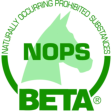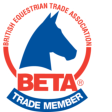in basket
TOP OFFER - SUMMER20 - 20% OFF and 4 FREE seasonal products!
Managing your horse’s pasture

Introduction
Pasture is so important for horses and is used for a variety of purposes; it is a source of food, an exercise area and a social environment where horses can interact with each other. Your horse may be turned out 24/7 all year round, or 24/7 in the spring and summer months, or turned out for several hours daily and stabled for the remainder of the day. Irrespective of how you manage your horse’s time at pasture, making sure your pasture is managed well is integral to helping maintain your horse’s health.
Stocking density
The term stocking density refers to the number of horses allowed to graze per acre (or hectare) of pasture for a specific amount of time. An acre of pasture is just under 4050 square metres while a hectare equates to 2.47 acres. The British Horse Society guidelines are that each horse should have access to 1 to 1.5 acres of grazing. However, this very much depends on a number of factors including grazing behaviour, pasture management, forage species, topography, how much grass is present, time of year, length of growing season and weather. Other factors that affect stocking density include your horse’s age, breed, workload, weight and body condition score, and number of hours at grass per day, and whether other species are co-grazing on the pasture.
Water supply
The term stocking density refers to the number of horses allowed to graze per acre (or hectare) of pasture for a specific amount of time. An acre of pasture is just under 4050 square metres while a hectare equates to 2.47 acres. The British Horse Society guidelines are that each horse should have access to 1 to 1.5 acres of grazing. However, this very much depends on a number of factors including grazing behaviour, pasture management, forage species, topography, how much grass is present, time of year, length of growing season and weather. Other factors that affect stocking density include your horse’s age, breed, workload, weight and body condition score, and number of hours at grass per day, and whether other species are co-grazing on the pasture.
Grazing your pasture for horses
Many people graze their pastures continuously, whereby the horses have free-ranged access that is uncontrolled. However, other approaches can be beneficial, such as rotational grazing where the field is divided into a series of smaller areas or paddocks. In this system, the different paddocks can be grazed in sequence, often a 21-day rotation is used, which allows for grass growth between grazing periods. This can be managed as either 3, 7-day grazing rotations or 7, 3-day rotations. Strip grazing is a variant of this where electric fencing is used to section off sections of a larger field.
Pastures should periodically be rested from grazing so that it can recover, which prevents it becoming what is known as ‘horse-sick’. As a general rule of thumb grass length should be between 6 to 8 cm tall for horses. Therefore, pastures need to be rested if grass length is less than 4 cm, but if over 10 cm then this is considered too long for horses – in practical terms the wellie boot test can be helpful; if the grass is over the foot of your wellie then it is too long for horse grazing. Horses should also only be grazed on established pastures because grazing on newly sown areas can lead to gastrointestinal disturbances such as colic and laminitis. Some farmers/land owners may manage their land as they would for cattle and sheep, but this is not recommended for horses. The types of grasses used for dairy cattle for example are also unsuitable for your horse as they typically contain grass species (fast growing ryegrasses) that accumulate high levels of fructan, which may lead to colic and laminitis (see previous article on understanding your pasture). Grass pastures for horses should ideally contain perennial ryegrass, meadow fescue, timothy and meadow grass. The majority of the main pasture seed producers now supply pasture seed mixtures specifically designed for establishing pastures more suitable for horses. Finally, large quantities of clover should be avoided due to the high nitrogen content, which again may lead to gastrointestinal disturbance in horses.
It can be helpful to graze other species on the pasture when horses are not grazing on it, if possible. This can be beneficial for helping to maintain the pasture because whilst horses tend to have ‘patchy’ selective grazing habits, meaning they tend to under-graze certain areas and over-graze others. Cattle are not as selective and often graze areas that are avoided by horses while sheep also have a different grazing patterns; they are not as selective as horses and also graze closer to the ground than cattle. Therefore, cattle and sheep are considered to complement the grazing patterns of horses, which can benefit pasture management/quality.
It is important to consider the fencing used for horse pastures. They should be safe and secure to prevent horses from escaping or injuring themselves. The types of fences that are suitable include; post and rail, electric tape, stone walls, hedges and plastic fencing. Barbed or single wire is commonly used for cattle but should be avoided for horses as this can cause injury, which needs to be taken into account when either co-grazing or rotating grazing with other species.
Parasites
In addition to cattle and sheep helping to maintain the pasture, they can also be beneficial to parasite control. Because different parasites affect certain hosts and therefore either co-grazing or rotation of species grazing the pasture is beneficial if possible as it can help to reduce the overall ‘worm-burden’ in the pasture for a given species. Removal of droppings is also a vital part of pasture management and should ideally be done every one to two days to help reduce parasite burden. Faecal worm egg counts (FWECs) are useful at certain times of the year to determine horses with high worm burdens. Around 80 % of the worm burden resides in around 20% of the horse population and so FWECs help to provide targeted deworming of specific animals susceptible to parasites. A horse is considered to require treatment with a deworming drug (anthelmintic) if their faeces contains more than 200 eggs per gram. It is recommended that horses have their faeces tested every 6 to 8 weeks and are dewormed according to the results. FWECs do not detect encysted larvae or accurately determine tapeworm numbers as discussed above and thus if a FWEC programme is used then a dewormer targeting encysted larvae and tapeworm should be used in all grazing horses once per year regardless of FWEC results.
Poisonous plants for horses
Poisonous plants for horses include bracken, yew, foxglove, privet, deadly nightshade and hemlock. Ragwort is also poisonous to horses and can cause acute or chronic liver damage both when eaten fresh or when cut and dried in hay. The sycamore tree is also poisonous along with the acorns from oak trees and therefore these trees should be fenced off from horses.
General horse pasture management
In springtime it can be helpful to take a soil sample for analyses to help inform what (if any) fertiliser is required and/or if lime or sulphur is needed to address any soil pH issues. Late spring can be a good time to harrow the field to remove any dead grass and aerate the soil, but in pastures associated with equine grass sickness it is not recommended to harrow the field. This is also a good time to reseed any poached areas, which can also be rolled to flatten out these areas. Late spring is also a good time to do faecal worm egg counts and address any parasite burden as well as routinely treating for tapeworm.
During summer, remove any poisonous plants that tend to be present at this time of year and take the opportunity to top the pasture (remove long strands of grass) to remove any dead, dry or long herbage. This encourages the grass to grow and improves the density of the pasture. It also helps address any tainted areas of grass that are not being eaten. The pasture must not be grazed until the cut grass has been removed or has completely dried out as this can cause gastrointestinal issues, such as the development of colic.
In the autumn, take the time to remove any weeds to prevent them seeding and spreading and this is also a good time to make sure fences are attended to and hedges etc cut back. Repeating FWECs at this time is also recommended as well as treating for tapeworm and encysted small red worms. Remember that in the autumn the leaves will be falling from the trees and it is important that leaves of sycamore trees do not spread onto the pasture, so they may need blown into a pile and removed. During winter, try to rotate pastures to prevent them becoming overly poached and, if possible, have some hard standing by gates as these areas tend to become poached very quickly.
Article written for Premier Performance CZ Ltd. by Professor Jo-Anne Murray.






